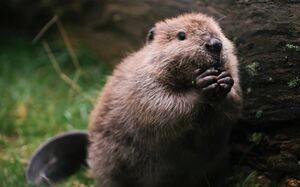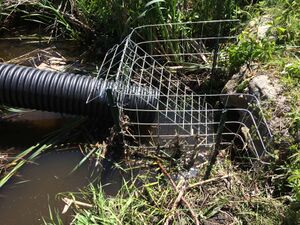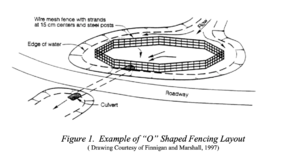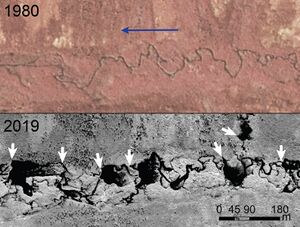Course:CONS200/2023WT1/Beaver colonization in the Arctic: Causes and potential consequences
Introduction


Beavers are semi-aquatic rodents recognized for their remarkable ability to shape landscapes through dam construction. These industrious animals are members of the genus Castor and have historically inhabited freshwater systems across North America, Europe, and Asia1[1]. The primary purpose for dam building is to create a water barrier against predators and to access food during winter. Throughout their existence, they've played a significant role in shaping aquatic habitats and have adapted successfully to their environments. However, because of their population expansion into the arctic area, beavers contribute to the issue of rising global temperature.
History of beaver in arctic
Historically, the Arctic tundra was not an appropritae environment for beavers. The treeline functioned as a natural barrier to keep beavers from crossing the cold, treeless tundra of the Arctic, which is unsuitable for beaver habitation. According to past records like those from Bockstoce in 2009 and McCulloch & Hopkins in 1966[1], beavers had a range limit separated by the treeline. Yet recent research suggests that beavers are residing beyond the traditional boundaries observations while building new dams. It indicates that their habitat preferences have shifted. This alteration may emphasise the adaptability of beavers in the face of environmental changes.
What led to the colonization of the Arctic by beaver
The colonization of the Arctic tundra by beavers is influenced by both environmental and behavioral factors[1]. The rising temperature of climate change and diminishing ice cover, has transformed the Arctic into a more ideal environment for species traditionally limited to warmer zones. This shift has resulted in longer ice-free seasons, enabling beavers to explore and establish themselves in previously unvisited territories[1]. The accompanying changes in the tundra stream have created conditions for beaver activities, especially dam construction[1].
Beavers' innate adaptability further helps their migration northward. Their extraodinary skills in constructing dams and nests not only keep them secure but also assure their food supply during the hard Arctic winters[1]. These creatures inevitably reshape local ecosystems as they colonise new areas, potentially affecting physical processes and salmon habitats[1].
As the Arctic gets warmer, more shrubs and plants grow, providing beavers with a plentiful supply of resources for food and building dams[1]. The melting of permafrost has led to an expansion of wetland habitats, generating even more opportunities for beaver colonization[1]. Furthermore, the competition in these new areas has reduced, allowing beavers to carve out new territories without much resistance[1].
Methods for tracking changes in the beaver population and how the beaver population changed over time
Satellite imaging has been a critical tool in understanding changes in beaver activity in the Arctic. The study used Landsat-based trend analysis to map the wetting and drying in the Arctic (Figure 1)[1]. Pixels showing wetness or drying, which corresponded to beaver activity patterns, were selected for further research. The findings were then validated using high-resolution commercial satellite imagery, such as Quickbird, IKONOS, and GeoEye[1].
The results from this high-resolution time series imagery analysis were surprising. Beavers began colonising the Arctic tundra of northeastern Alaska between 1999 and 2014[1]. 80% of the wetness locations were confirmed as active beaver sites out of the 70 places where possible beaver dam construction activity was found. Interestingly, while some of the mapped wetness sites did not show signs of beaver activity, a significant number indicated the existence of beavers in previously uninhabited areas.
By examining satellite imagery and comparing it with historical data, it is evident that beavers are extending their habitat, with the Arctic tundra now becoming a part of it. This movement, influenced by changing environmental conditions, highlights the dynamic nature of wildlife migration patterns and the unforeseen impacts of global climate change.
Impacts with the colonization of beaver in the Arctic

Impact on the water system
According to the study and observation from the scientists, the overall downstream MeHg (Methylmercury) concentrations in pioneer beaver systems were significantly higher than the upstream concentrations during the entire study period[2].The downstream with most of the pioneer species have to build dams and create their habitat to survive. With the disturbance of these pioneer beavers, more flooded areas are formed which are under anaerobic conditions[3]. Under these circumstances, this thrives in the growth of sulfur-reducing bacteria. This kind of bacteria converts mercury into methylmercury which is known as toxic for any living organism. Therefore we tend to see a much higher concentration of MeHg downstream dominated by pioneer beavers.[4] Even a small dosage can cause an alteration in both structure and function in any organism[5]. With the colonization of beavers increasing the concentration of MeHg will not only affect beaver itself but also other aquatic species living in the region.
Impact on climate change
The beavers' activities have strongly impacted the hydrology and permafrost in the Arctic. Through observations, widespread beaver pond construction has rapidly grown through these years. Beavers are now a major effect of surface water dynamics. Surface water is the accelerator of permafrost thawing. Therefore with more beavers constructing dams and networking channels in the water, more thawing of permafrost soil. Permafrost soil holds approximately twice the carbon that the atmosphere can, so by thawing the permafrost soil releases a large amount of carbon dioxide and methane into streams and the atmosphere[6]. Consequently, greenhouse gases accumulate in the atmosphere, escalating climate change and intensifying the effects of global warming in the region[7].
Beavers' construction of habitat not only affects permafrost but also significantly affects the water flow. With dams and channels, it alternates the water flow and often blocks water flow. These changes can have far-reaching effects on the hydrological regime, creating wetlands areas and changing water flow patterns. As a result, the colonization of beavers influences the distribution and availability of water in the Arctic.
Impact on other species
In the Arctic, Beavers always dig down into the water when they construct their habitat. It is typical in the Arctic that the deep water is warmer due to the fact that there is more unfrozen water beneath the ice cover than the shallow water. Beaver ponds become a warm water refugia downstream for fish and biota that were previously unable to spawn or survive in the Arctic due to the cold temperature or limit of nutrient resources[6]. The establishment of these newly constructed beaver ponds introduces a new disturbance regime and biological environment, likely increasing biodiversity. More species are able to survive and thrive in the Arctic due to beaver colonization creating a much more adaptable living environment.
Current management regime
Installed physical barriers
Beaver baffles:

A Beaver baffle is a simple device consisting of an iron cage and long pipe to help control the water inflow when beavers build dams and to disrupt the dam structure from forming without harming the beaver. It appears effective in Arctic tundra since it effectively prevents beaver population expansion and cuts down the dam numbers – one of the major contributors to thawing. However, it is not enough to resolve the whole beaver colonization problem, since it is site-dependent including variables of water volume, water depth, and required maintenance every 1-2 years, which is not that cost-efficient, and can only be applied on a small scale [5].

Beaver fencing:
The fencing technique is another way to prevent beaver from getting upstream, without blocking the stream flow. For fencing to be effective, the opening should be no more than 15 cm each and placed slightly above the winter water mark of the watercourse. The fencing curbs the urge of beavers to build dams at the culvert by moving them further and further away from the culvert and ultimately, the stimulus. The exclusion fence has already shown the success in North America, but has not yet been applied to the Tundra region[2].
Animal management:
Trapping and minor culls:
With the significant increase in the beaver population, non-lethal strategies could be ineffective. Therefore, targeted culling and trapping could be necessary and unavoidable. According to current Beaver management strategies, if the physical barriers preventing Beaver from colonization fail, the culling appears to be the only alternative. However, the timing and size of culling need to be carefully determined. For instance, regular culling at the slow establishment stage may trigger the rapid re-colonization of the rest of the animals and disturb the Arctic's ecosystem[8].
Future trend prediction

By analyzing the combination factors of historical beaver dams distribution, climate change rate in the Arctic region, and the Beavers’ internal adaptability features, the beaver population will flourish at an accelerating speed in the Arctic region. Over the past 3 decades, the Arctic region has been significantly influenced by global warming, expressed in increasing summer length, shorter snow-cover duration periods in winter and heavier precipitation in autumn, which foster the growth of shrubs and increase tundra productivity[9]. With the shift in biome into the beaver's tolerance range, the beaver population shifted poleward and started colonizing the Arctic 20 years ago[10]. The ability of beavers to thrive in greatly herbaceous vegetation-dominated ecosystems, reinforce the evidence for what appears to be an ongoing beaver invasion of low Arctic tundra ecosystems. Based on research conducted by Tape et al[4]. which integrates Indigenous Knowledge to trace beaver activity through the analysis of bones and teeth, it is demonstrated that beaver activities exhibit a strong correlation with climate change. However, there is no indication that the trend of climate change is abating; rather, warming is expected to persist significantly based on future changes simulated with prescribed relative concentration pathways scenarios in the Arctic [11].In this case, the exponential growth of the beaver population in the Arctic region appears inevitable if effective control measures over climate change are not implemented. The accelerating trend of the beaver population is not solely attributed to climate change but is also supported by satellite imagery tracking the number of dams built by beavers. For instance, in the northern Baldwin Peninsula study region, the number of beaver dams increased from 94 to 409 between 2010 and 2019, as depicted in the imagery. This emphasizes the urgent need for comprehensive strategies that address both climate change and beaver activities to prevent unchecked population growth in the Arctic[12].
Future Remedial Actions

Dam removal:
Removal of beaver dams that block the migration and movement routes of Arctic species can help improve their populations. The efficiency of the clean-up process can be greatly improved through organized cooperation with First Nations, while more advanced machinery can be used to quickly restore the ecosystem to its original state[13].
Hunting/trapping of beavers:
Managing beaver populations through hunting and trapping can help control their presence and minimize their impact on the habitat of Arctic species. In the future we recommend the use of more humane methods of treatment, as well as improved standards of welfare for hunters, and ultimately the integration of environmental restoration projects with the interests of local communities[14].
Managing Riparian vegetation:
Managing vegetation near rivers(riparian zones) can help create more suitable habitat for arctic native species. This may require maintenance and enhancement of vegetation to provide shade, cover, and food sources for fish[15].
Stream Improvement:
Ongoing stream improvement projects can improve the steam system by removing obstructions such as rocks or beaver scat, providing access around waterfalls, or redirecting water flow. These projects should be carefully organized and prioritized based on the specific needs of each stream[15].
Funding for beaver removal and stream enhancement:
Allocating more funding for beaver removal efforts, including increasing the price of beaver fur to encourage hunting, can help control the beaver population. Additionally, securing funding for stream enhancement projects, such as through programs like the Climate Change Preparedness in the north program, can support the improvement of river systems[16].

Collaboration with indigenous trappers and communities:
Collaborating with Cree or Naskapi trappers and involving community members, including Inuit fishermen, in monitoring and research efforts can provide valuable insights and ensure that management strategies align with local knowledge and priorities[16].
Monitoring:
monitoring of arctic native species, water quality, and environmental factors can provide valuable data for understanding the health and trends of the biological population. This information can guide future management studies and measure the effectiveness of remedial measures[16].
Challenges
1: The lack of experience with beaver trapping among most Inuit communities adds to the challenge of managing their population[16].
2: Climate change presents us with new and unprecedented problems, such as thawing permafrost, extreme weather events and changes in precipitation, and many existing plans will have to be altered from their original form[16].
3: Lack of communication and collaboration between local residents and other stakeholders.
4: Pollutants generated in our efforts to manage local conditions. (Very difficult to break down in cold natural environments)
Conclusion
Despite the generally acknowledged role of the beaver as a keystone species providing a range of ecological benefits, the impact of beaver activities in colonizing tundra has more negative implications outweighing the benefits. Beaver colonization has brought severe impacts on the water system, regional climate, and original tundra species. The expansion, mainly driven by climate change and habitat alterations, poses both challenges and opportunities for Arctic ecosystems. Their dam-building activities notably impact water systems and biodiversity. This situation underscores the necessity for ongoing research and adaptive management strategies to balance ecological integrity with the evolving dynamics of Arctic wildlife and habitats.The current management regime combines both physical barriers, including beaver baffles and beaver fencing, and traditional management, including minor culls and trapping. However, both strategies are more effective and applicable in the short-term dam removal but hardly fully address the beaver colonization cycle, based on the climate trajectory—the greatest contributor to beaver colonization. Therefore, based on climate trajectory and satellite prediction, the beaver population will grow in the Arctic region without launching more effective mitigations. To enhance and refine future remedial actions, strategies from both ends (number control and monitoring aspects) need to be applied and improved.
References
| This conservation resource was created by Course:CONS200. It is shared under a CC-BY 4.0 International License. |
- ↑ 1.00 1.01 1.02 1.03 1.04 1.05 1.06 1.07 1.08 1.09 1.10 1.11 1.12 "Tundra be dammed: Beaver colonization of the Arctic".
- ↑ 2.0 2.1 Levanoni, Oded; Bishop, Kevin; Mckie, Brendan G.; Hartman, Goran; Eklof, Karin; Ecke, Frauke (October 9, 2015). "Impact of Beaver Pond Colonization History on Methylmercury Concentrations in Surface Water". American Chemical Society. Retrieved November 2, 2023.
- ↑ Larson, Joshua (July 2021). "Dam builders and their works: Beaver influences on the structure and function of river corridor hydrology, geomorphology, biogeochemistry and ecosystems". Earth Science Review. 218 – via Science Direct.
- ↑ 4.0 4.1 Clark, Jason A.; Tape, Ken D.; Baskaran, Latha; Elder, Clayton; Miller, Charles; Miner, Kimberly; O'Donnell, Johnathan A.; Jones, Benjamin A. (3 July 2023). [10.1088/1748-9326/acde8e "Do beaver ponds increase methane emissions along Arctic tundra streams?"] Check
|url=value (help). Environmental Research Letters. Retrieved December 15, 2023. - ↑ 5.0 5.1 Chan, Laurie Hing Man (June 2019). "Mercury and Methylmercury Toxicology and Risk Assessment". MDPI. Retrieved November 2, 2023.
- ↑ 6.0 6.1 Tape, Ken D.; Clark, Jason A.; Jones, Benjamin M.; Kantner, Seth; Gaglioti, Benjamin V.; Grosse, Guido; Nitze, Ingmar (May 3, 2022). "Expanding beaver pond distribution in Arctic Alaska, 1949 to 2019". National Library of Medicine. Retrieved November 2, 2023.
- ↑ [www.sciencedaily.com/releases/2023/09/230907205925.htm "Beaver activity in the Arctic increases emission of methane greenhouse gas"] Check
|url=value (help). ScienceDaily. 2023, September 7. Retrieved December 15, 2023.|first=missing|last=(help); Check date values in:|date=(help) - ↑ Scott, James (2015). "Managing wild Eurasian beavers: a review of European management practices with consideration for Scottish application" (PDF). Commissioned Report No. 812. – via Scottish Natural Heritage. line feed character in
|title=at position 44 (help) - ↑ WWF (Dec 15 2023). "Climate Change". Check date values in:
|date=(help) - ↑ Descamps,S., Strøm,H. (July 21 2021). "As the Arctic becomes boreal: ongoing shifts in a high-Arctic seabird community". Ecology. 102. Check date values in:
|date=(help)CS1 maint: multiple names: authors list (link) - ↑ Smith, S.J. (August 2011). "The RCP greenhouse gas concentrations and their extensions from 1765 to 2300". Climate Change – via Springerlink.
- ↑ Benjamin M; et al. (June 2020). "Increase in beaver dams controls surface water and thermokarst dynamics in an Arctic tundra region, Baldwin Peninsula, northwestern Alaska". Enviromental Research letter. 15 – via IOP Publishing Ltd. Explicit use of et al. in:
|last=(help) - ↑ Neelin, Mikhaela Nadya. sourcetype=Dissertations%20&%20Theses "Beavers (Castor Canadensis) in Nunavik: Integrating Multiple Ways of Knowing to Address Climate Change Concerns Related to the Expansion of Boreal Species into Tundra Regions" Check
|url=value (help). - ↑ Sigfrid, Kjeldaas. "Samuel Hearne, the Denesuline, and the Beaver".
- ↑ 15.0 15.1 Bruce, Smith; Don, Prichard. RIPARIAN AREA MANAGEMENT. U.S. Department of the Interior Bureau of Land Management Service Center.
- ↑ 16.0 16.1 16.2 16.3 16.4 Mikhaela, Neelin (2021). ARCTIC CHAR IN A CHANGING CLIMATE. Makivik Corporation.
